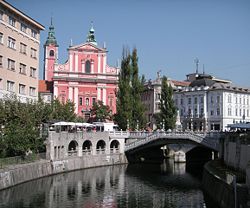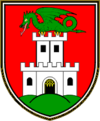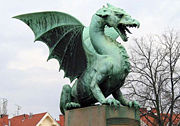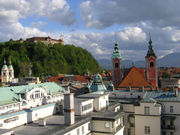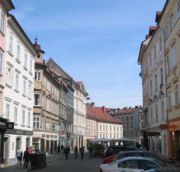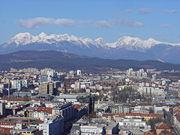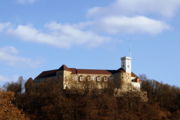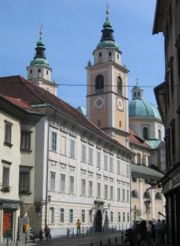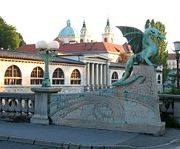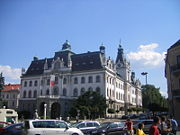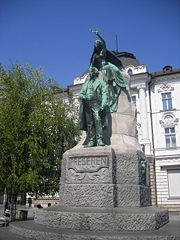Ljubljana
2008/9 Schools Wikipedia Selection. Related subjects: Europe; European Cities
Coordinates:
| Ljubljana | |||
| Triple Bridge above the Ljubljanica River and Prešeren Square | |||
|
|||
| Municipal location in Slovenia | |||
| Coordinates: | |||
|---|---|---|---|
| Country | Slovenia | ||
| First mention | 1144 | ||
| Government | |||
| - Mayor and governor | Zoran Janković ( Lista Zorana Jankovića) | ||
| Area | |||
| - Total | 275.0 km² (106.2 sq mi) | ||
| Elevation | 298 m (978 ft) | ||
| Population (2007) | |||
| - Total | 267,920 | ||
| Time zone | CET ( UTC+1) | ||
| - Summer ( DST) | CEST ( UTC+2) | ||
| Area code(s) | 01 | ||
| Vehicle Registration | LJ | ||
| Website: www.ljubljana.si | |||
Ljubljana (pronounced [ʎubˈʎa:nʌ]) is the largest and capital city of Slovenia. It is located in the center of the country and is a mid-sized city of some 270,000 inhabitants. Ljubljana is regarded as the cultural, scientific, economic, political and administrative centre of Slovenia, independent since 1991. Throughout its history, it has been influenced by its geographic position at the crossroads of German, Latin and Slavic culture.
Its transport connections, concentration of industry, scientific and research institutions and industrial tradition are contributing factors to its leading economic position. Ljubljana is the seat of the central government, administrative bodies and all government ministries of Slovenia. It is also the seat of Parliament and of the Office of the President.
Etymology and symbol
Historians disagree about the origins of the city's name. Some believe it derives from ancient Slavic city called Laburus. Others think the word comes from the Latin Aluviana following a flood in the town. It could also come from Laubach ("marsh"). Finally, some hypothesize the Slavic word Luba ("beloved") as its origin.
According to the celebrated Greek legend, the hero Jason and his Argonauts, after finding the Golden Fleece in Colchis, ended up going northward by sailing on the Danube rather than returning toward the Aegean Sea. Going up, it is said they went toward its tributary the Sava and then to the source of the river Ljubljanica. They disembarked in order to carry their boat to the Adriatic Sea, located to the west, in order to return home. Between the present-day cities of Vrhnika and Ljubljana, the Argonauts found a large lake surrounded by a marsh. It is there that Jason struck down a monster. This monster was the dragon that today is present on the city's coat of arms and flag. Several winged dragons also decorate the Dragon Bridge (Zmajski Most). This bridge, built between 1900 and 1901, is the work of J. Zaninovič. The dragon is also a symbol of the nearby Austrian city of Klagenfurt that was, through the centuries, Slovenia's great spiritual centre.
History
Around 2000 BC, the marshes of Ljubljana were settled by people living in wooden structures on pilotis. These people lived through hunting, fishing and primitive agriculture. To get around the marshes, they used dugout canoes made by cutting out the inside of tree trunks. Later, the area remained a transit point for numerous tribes and peoples. The land was first settled by the Veneti, followed by an Illyrian tribe called the Yapodi and then in the 3rd century BC a Celtic tribe, the Taurisci.
Around 50 BC, the Romans built a military encampment that later became a permanent settlement called Iulia Aemona ( Emona). This entrenched fort was occupied by the Legio XV Apollinaris. In 452 it was destroyed by the Huns under Attila's orders, and later by the Ostrogoths and the Lombards. Emona housed 5-6,000 inhabitants and played an important role during numerous battles. Its plastered brick houses, painted in different colours, were already connected to a drainage system. In the 6th century, the ancestors of the Slovenes moved in. In the 9th century, the Slovenes fell under Frankish domination, while experiencing frequent Magyar raids.
The name of the city, Luvigana, appears for the first time in a document from 1144. In the 13th century, the town was composed of three zones: the Stari trg ("old square"), the Mestni trg ("town square") and the Novi trg ("new square"). In 1220, Ljubljana was granted city rights, including the right to coin its own money.
In 1270, Carniola and in particular Ljubljana was conquered by King Ottokar II of Bohemia. When he was in turn defeated by Rudolph of Habsburg, the latter took the town in 1278. Renamed Laibach, it would belong to the House of Habsburg until 1797. The Diocese of Ljubljana was established in 1461 and the Church of St. Nicholas became a cathedral.
In the 15th century Ljubljana became recognized for its art. After an earthquake in 1511, it was rebuilt in Renaissance style and a new wall was built around it. In the 16th century, the population numbered 5,000, 70% of whom spoke Slovene as their mother tongue. In 1550, the first two books written in this language were published there: a catechism and an abecedarium, followed by a Bible translation. Around the same time, the first secondary school, public library and printing house opened in Ljubljana. In 1597, the Jesuits arrived and built a new secondary school that later became a college. Baroque architecture appeared at the end of the 17th century as foreign architects and sculptors came in.
The Napoleonic interlude saw Ljubljana become, from 1809 to 1813, the capital of the Illyrian Provinces. In 1815, the city became Austrian again and from 1816 to 1849 was part of the Kingdom of Illyria. In 1821 it hosted the Congress of Laibach, which fixed European political borders for years to come. The first train arrived in 1849 from Vienna and in 1857 the line was extended to Trieste. Public electric lighting appeared in 1898. In 1895, Ljubljana, then a city of 31,000, suffered a serious earthquake measuring 6.1 on the Richter scale. Some 10% of its 1,400 buildings were destroyed, although casualties were light. During the reconstruction that followed, a number of quarters were rebuilt in Art Nouveau style.
In 1918, following the end of World War I and the dissolution of Austria-Hungary, the region joined the Kingdom of Serbs, Croats and Slovenes. In 1929, Ljubljana became the capital of Drava Banovina, a Yugoslav province. In 1941, during World War II, Fascist Italy occupied the city, followed by Nazi Germany in 1943. It was surrounded by over 30 kilometres (19 mi) of barbed wire as the collaborationist Slovene Home Guard (Slovensko Domobranstvo) confronted the Yugoslav Partisans (Partizani). Since 1985, a commemorative path has ringed the city where this iron fence once stood.
After World War II, Ljubljana became the capital of the Socialist Republic of Slovenia, part of Communist Yugoslavia, a status it retained until 1991, when Slovenia became independent. Ljubljana remained the capital of Slovenia, which entered the European Union in 2004.
Geography and climate
The city, with an area of 275.0 square kilometres (106.2 sq mi), is situated in central Slovenia. Its location between Austria, Hungary, the Venice region in Italy and Croatia has strongly influenced its history. Ljubljana is located some 140 kilometres (87 mi) west of Zagreb, 250 kilometres (160 mi) northwest of Venice, 350 kilometres (220 mi) southwest of Vienna and 400 kilometres (250 mi) southwest of Budapest.
Topography and hydrography
The city is located at an altitude of 298 metres (980 ft) in the valley of the river Ljubljanica between the Kras region and the Julian Alps. The castle, which sits atop a hill south of the city centre, is at 366 metres (1,200 ft) altitude while the city's highest point, called Janški Hrib, reaches 794 metres (2,600 ft).
Ljubljana is near the confluence of the rivers Ljubljanica and Sava, at the foot of Castle Hill. The Sava, in turn, flows into the Danube at Belgrade before reaching the Black Sea.
Geology
The city stretches out on an alluvial plain dating to the Quaternary era. The nearby, older mountainous regions date back to the Mesozoic (Triassic) or Paleozoic.
A number of earthquakes have devastated Ljubljana, including in 1511 and 1895. Slovenia is in a rather active seismic zone because of its position to the south of the Eurasian Plate. Thus the country is at the junction of three important tectonic zones: the Alps to the north, the Dinaric Alps to the south and the Pannonian Basin to the east. Scientists have been able to identify 60 destructive earthquakes in the past. Additionally, a network of seismic stations is active throughout the country.
Climate
The city's climate and that of eastern Slovenia is of the continental type. In general, July is the hottest month while January and February are the coldest. The coldest temperature ever recorded was −28 °C (−18.4 °F) while the warmest was 39 °C (102 °F). Frost is possible from October through May. The driest months are from January to April, with less than 100 millimetres (3.9 in) of precipitation, while September and October are the wettest months.
| Month | Jan | Feb | Mar | Apr | May | Jun | Jul | Aug | Sep | Oct | Nov | Dec | Year |
|---|---|---|---|---|---|---|---|---|---|---|---|---|---|
| Record high temperatures (°C/°F) | 14/57 | 19/66 | 23/73 | 30/86 | 31/88 | 38/100 | 39/102 | 35/95 | 31/88 | 27/81 | 20/68 | 16/61 | 39/102 |
| Average high temperatures (°C/°F) | 2/36 | 5/41 | 10/50 | 15/59 | 20/68 | 24/75 | 27/81 | 26/79 | 22/72 | 15/59 | 8/46 | 4/39 | 15/59 |
| Average low temperatures (°C/°F) | -4/25 | -4/25 | 0/32 | 4/39 | 9/48 | 12/54 | 14/57 | 14/57 | 11/52 | 6/43 | 2/36 | -1/30 | 5/41 |
| Record low temperatures (°C/°F) | -27/-17 | -28/-18 | -16/3 | -5/23 | -3/27 | 4/39 | 7/45 | 4/39 | 1/34 | -2/28 | -11/12 | -15/5 | -28/-18 |
| Average monthly precipitation (mm/in) | 88/3.5 | 89/3.5 | 76/3.0 | 98/3.6 | 121/4.8 | 133/5.2 | 113/4.4 | 127/5.0 | 142/5.6 | 151/5.9 | 131/5.2 | 114/4.5 | 1,383/54.4 |
Districts
Ljubljana has 17 districts, listed below. It was formerly composed of five municipalities (Bežigrad, Centre, Moste-Polje, Šiška and Vič-Rudnik) that still correspond to the main electoral constituencies of the city.
|
|
Structures
Architecture
Despite the appearance of large buildings, especially at the city's edge, Ljubljana's historic centre remains intact; there, Baroque and Art Nouveau styles mix. The city is strongly influenced by the Austrian fashion in the style of Graz and Salzburg.
The old city is made up of two districts: one includes Ljubljana town hall and the principal architectural works; the other, the neighbourhood of the Chevaliers de la Croix, features the Ursuline church, the philharmonic society building (1702) and the Cankar house.
After the 1511 earthquake, Ljubljana was rebuilt in a Baroque style following the model of a Renaissance town; after the 1895 quake, which severely damaged the city, it was once again rebuilt, this time in an Art Nouveau style. The city's architecture is thus a mix of styles. The large sectors built after the Second World War often include a personal touch by the Slovene architect Jože Plečnik.
Ljubljana Castle dominates the hill over the river Ljubljanica. Built in the 12th century, the castle was the residence of the Margraves, later the Dukes of Carinthia. Aside from the castle, the city's main architectural works are St. Nicholas Cathedral, St. Peter's Church, the Franciscan Church of the Annunciation, the Triple Bridge and the Dragon Bridge.
Near town hall, on the Mestni Trg square, is Robba's fountain, in Baroque style. Resembling the fountain on Rome's Piazza Navona, it is decorated with an obelisk at the foot of which are three figures in white marble symbolising the three chief rivers of Carniola. It is the work of Francesco Robba, who designed numerous other Baroque statues in the city. Ljubljana's churches are equally marked by this style that gained currency following the 1511 earthquake.
For its part, Art Nouveau features prominently on Prešeren Square and on the Dragon Bridge. Among the important influences on the city was the architect Jože Plečnik, who designed several bridges, including the Triple Bridge, as well as the National Library. Nebotičnik is a notable high-rise.
Ljubljana Castle
Ljubljana Castle (Ljubljanski grad) is a mediaeval castle located at the summit of the hill that dominates the city centre. The area surrounding today's castle has been continuously inhabited since 1200 BC. The hill summit probably became a Roman army stronghold after fortifications were built in Illyrian and Celtic times.
The castle is first mentioned in 1144 as the seat of the Duchy of Carinthia. The fortress was destroyed when the duchy became part of the Habsburg domains in 1335. Between 1485 and 1495, the present castle was built and furnished with towers. Its purpose was to defend the empire against Ottoman invasion as well as peasant revolt. In the 17th and 18th centuries, the castle became an arsenal and a military hospital. It was damaged during the Napoleonic period and, once back in the Austrian Empire, became a prison, which it remained until 1905, resuming that function during World War II. The castle's Outlook Tower dates to 1848; this was inhabited by a guard whose duty it was to fire cannons warning the city in case of fire or announcing important visitors or events.
In 1905, the city of Ljubljana purchased the castle, which underwent a renovation in the 1960s. Today, it is a tourist attraction; cultural events also take place there. Since 2007, a funicular has linked the city centre to the castle atop the hill..
St. Nicholas Cathedral
St. Nicholas Cathedral of Ljubljana (Stolnica svetega Nikolaja) is the city's only cathedral. Easily identifiable due to its green dome and twin towers, it is located on Vodnik square near the Triple Bridge.
Originally, the site was occupied by a three-nave Romanesque church first mentioned in 1262. After a fire in 1361 it was re-vaulted in Gothic style. The Diocese of Ljubljana was set up in 1461 and eight years later, a new fire presumably set by the Ottomans once again burnt down the building.
Between 1701 and 1706, the Jesuit architect Andrea Pozzo designed a new Baroque church with two side chapels shaped in the form of a Latin cross. The dome was built in the centre in 1841.The interior is decorated with Baroque frescos painted by Giulio Quaglio between 1703-1706 and 1721-1723.
Dragon Bridge
The Dragon Bridge (Zmajski most) was built between 1900 and 1901, when the city was part of Austria-Hungary. Designed by a Dalmatian architect who studied in Vienna and built by an Austrian engineer, the bridge is considered one of the finest works in the Vienna Secession Art Nouveau style. Some residents nicknamed the bridge "mother-in-law" in reference to the fearsome dragons on its four corners.
Demographics
In 1869, Ljubljana had 22,593 inhabitants, a figure that grew to 80,000 by the mid-1930s. Demographic growth remained fairly stable between 1999 and 2007, with a population of about 270,000. Before 1996, the city's population surpassed 320,000 but the drop that year was mainly caused by a territorial reorganisation that saw certain peripheral districts attached to neighbouring municipalities. At the 2002 census, 39.2% of Ljubljana residents were Roman Catholic; 30.4% were believers who did not belong to a religion, unknown or did not reply; 19.2% were atheist; 5.5% were Eastern Orthodox; 5.0% were Muslim; and the remaining 0.7% were Protestant or belonged to other religions.
Demographic evolution
| 1999 | 2000 | 2001 | 2002 | 2003 | 2004 | 2005 | 2006 | 2007 |
|---|---|---|---|---|---|---|---|---|
| 270,481 | 271,654 | 270,032 | 269,146 | 268,084 | 267,192 | 266,935 | 267,369 | 267,920 |
Government and crime
Municipal elections take place every four years. Between 2002 and 2006, Danica Šimsič was mayor. Since the municipal elections of 22 October 2006, Zoran Janković, an important businessman in Slovenia, has been the mayor of Ljubljana, having won 62.99% of the votes. The majority on the city council (the mayor's own party) holds 23 of 45 seats. Among other roles, the council drafts the municipal budget, and is assisted by various boards active in the fields of health, sports, finances, education, environmental protection and tourism. The Ljubljana electoral zone is also composed of 17 districts that have local authorities working with the city council to make known citizens' suggestions and prepare activities in their districts.
The jurisdiction of the Ljubljana police (Policija) covers an area of 3,807 square kilometres (1,470 sq mi), which represents 18.8% of the national territory. There are 17 police stations employing 1,380 individuals, of whom 1,191 are police officers and 189 are civilians. With around 45,000 criminal acts in 2007, the Ljubljana police district alone accounts for over 50% of the country's crimes. Slovenia and in particular Ljubljana have a quiet and secure reputation.
Economy
Ljubljana produces about 25% of Slovenia's GDP. In 2003, the level of active working population was 62%; 64% worked in the private sector and 36% in the public sector. In January 2007, the unemployment rate was 6.5% (down from 7.7% a year earlier), compared with a national average of 8.7%.
Industry remains the city's most important employer, notably in the pharmaceuticals, petrochemicals and food processing. Other fields include banking, finance, transport, construction, skilled trades and services and tourism. The public sector provides jobs in education, culture, health care and local administration.
The Ljubljana Stock Exchange (Ljubljanska borza), purchased in 2008 by the Vienna Stock Exchange, deals with large Slovenian companies. Some of these have their headquarters in the capital region: for example, the retail chain Mercator, the oil company Petrol d.d. and the telecommunications concern Telekom Slovenije. Over 15,000 enterprises operate in the city, most of them in the tertiary sector.
Education
The Academy of the Industrious ( Academia operosorum Labacensis) opened in 1693; it closed in 1801 but was a precursor to the Slovenian Academy of Sciences and Arts, founded in 1938. Today, students make up one-seventh of Ljubljana's population, giving the city a youthful character. The University of Ljubljana, Slovenia's most important and Ljubljana's only university, was founded in 1919. As of 2008, it has 22 faculties, three academies and a college. These offer Slovenian-language courses in (among other subjects) medicine, applied sciences, arts, law and administration. The university has close to 64,000 students and some 4,000 teaching faculty.
In 2004, the national library and university library had 1,169,090 books in all. In 2006, the 55 primary schools had 20,802 pupils and the 32 secondary schools had 25,797.
Culture
Ljubljana has numerous art galleries and museums. In 2004, there were 15 museums, 41 art galleries, 11 theatres and four professional orchestras. There is for example an architecture museum, a railway museum, a sports museum, a museum of modern art, a brewery museum, the Slovenian Museum of Natural History and the Slovene Ethnographic Museum. The Ljubljana Zoo covers 19.6 hectares (48 acres) and has 152 animal species. An antique flea market takes place every Sunday in the old city. In 2006, the museums received 264,470 visitors, the galleries 403,890 and the theatres 396,440.
Each year over 10,000 cultural events take place in the city; among these are ten international festivals of theatre, music and art generally. Numerous music festivals are held there, chiefly in European classical music and jazz, for instance the Ljubljana Summer Festival (Ljubljanski poletni festival). In the centre of the various Slovenian wine regions, Ljubljana is known for being a "city of wine and vine". Grapevines were already being planted on the slopes leading up to the Castle Hill by the Roman inhabitants of Emona.
In 1701, present-day Slovenia's first philharmonic academy opened in Ljubljana, which spurred the development of musical production in the region. Some of its honorary members would include Joseph Haydn, Ludwig van Beethoven and Johannes Brahms, as well as the violinist Niccolò Paganini.
The National Gallery (Narodna galerija), founded in 1918, and the Museum of Modern Art (Moderna galerija), both in Ljubljana, exhibit the most famous Slovenian artists (among then Franz Caucig, 1755-1828). On Metelkova street there is a social centre dedicated to alternative culture, set up in a renovated former Austro-Hungarian barracks. This lively street has numerous clubs and concert halls that play various types of music, mainly alternative rock. In the 1980s, Ljubljana became the centre of the Neue Slowenische Kunst, which among others included the music group Laibach and the painters of the IRWIN collective; the philosopher Slavoj Žižek was also associated with it.
Sports
Ljubljana's ice hockey clubs are HD HS Olimpija, ŠD Alfa, HK Slavija and HDD Olimpija Ljubljana. They all compete in the Slovenian Hockey League and some also take part in the Austrian Hockey League. The basketball teams are KD Slovan, ŽKD Ježica Ljubljana and KK Union Olimpija. The latter, which has a green dragon as its mascot, hosts its matches in the 6,000-seat Tivoli Arena (Dvorana Tivoli), also the home rink of HDD Olimpija Ljubljana.
The city's football team, which plays in the Slovenian PrvaLiga, is Interblock Ljubljana.
In alpine skiing, the athlete Urška Hrovat won various awards, including at the Alpine skiing World Cup. The closest alpine skiing slopes are located 30 kilometres (19 mi) to the northwest, near Kamnik. The Krvavec resort (1,450 metres (4,800 ft)-1,971 metres (6,470 ft) high) ten ski lifts for 35 kilometres (22 mi) of slopes.
The 100 and 200 m track athlete Merlene Ottey, formerly Jamaican, has lived in Ljubljana since she became a naturalised Slovenian citizen in 2002, and represents her new country in international competitions.
Transport
Ljubljana is at the centre of the Slovenian road network, which links the city to all parts of the country. Until July 2008, a toll booths were used, but were replaced by a system using stickers valid for a year or at least six months. The city, in central Slovenia, is linked to the southwest by A1-E70 to the Italian cities of Trieste and Venice. To the north, A1-E57 leads to Maribor, Graz and Vienna. To the east, A2-E70 links it with the Croatian capital Zagreb, from where one can go to Hungary or important cities of the former Yugoslavia, such as Belgrade. To the northwest, A2-E61 goes to the Austrian cities of Klagenfurt and Salzburg, making it an important entry point for northern European tourists.
The bus network, run by the city-owned Ljubljanski Potniški Promet, is Ljubljana's only current means of public transportation. Usually, the buses are called trole ("trolleys"), harking back to the 1901-58 days when Ljubljana had trolley service (trole is used to refer only to Ljubljana's buses, and not those in other Slovenian cities). One can also rent bicycles in the city, and there are numerous taxi companies.
Ljubljana railway station is part of a railway network that links Germany to Croatia through the Munich-Salzburg-Ljubljana-Zagreb line. A second network is the Vienna-Graz-Maribor-Ljubljana one, which links Austria to Slovenia. A third is the Genoa-Venice-Ljubljana one, linking Ljubljana to Italy. Finally, a line goes to Budapest.
Ljubljana Airport ( IATA code LJU), located 26 kilometres (16 mi) north of the city, has flights to numerous European destinations. Among the companies that fly from there are Adria Airways, Air France, Brussels Airlines, EasyJet and Finnair. Among the destinations served are Amsterdam, Belgrade, Brussels, Budapest, Helsinki, London, Paris, Prague and Vienna.
Sister cities
|
|
